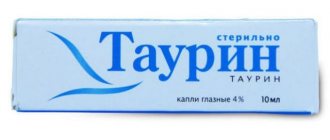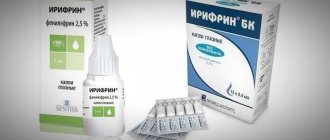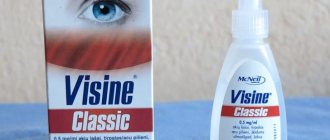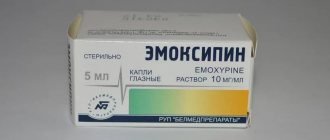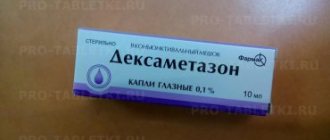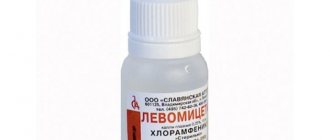Release form and composition
Available in the form of a lyophilisate (powder) for the preparation of drops used to treat viral eye diseases. A powder is also produced from which an injection solution and nasal drops are made.
Poludan is sold in 5 ml bottles and 1 ml ampoules.
| Lyophilisate | 1 ml |
| potassium polyriboadenylate | 50 mcg |
| potassium polyribouridylate | 53.5 mcg |
| Excipients: sodium hydrogen phosphate (2-substituted sodium phosphate), potassium dihydrogen phosphate (1-substituted potassium phosphate anhydrous), sodium chloride. | |
Adverse reactions
The most common negative consequences of using Poludan drops are local allergic reactions, accompanied by itching and burning in the eyes, a feeling of the presence of a foreign body, and intense lacrimation.
In some cases, follicles were found in the lower transitional skin fold. Sometimes an increase in pressure inside the eyes and minor hemorrhages were recorded during instillations of Poldan. All of these adverse reactions are mild and mild. They do not require specific treatment and go away on their own after discontinuation of the drug.
Indications for use
Viral eye diseases in children and adults, as well as treatment of such pathologies:
- herpetic keratoconjunctivitis;
- keratoiridocyclitis and keratitis;
- adenoviral keratoconjunctivitis;
- iridocyclitis, stromal keratitis;
- optic neuritis;
- chorioretinitis.
Nasal drops are used to treat various acute respiratory diseases, in particular influenza.
Injections of the solution are used to increase immunity in patients and treat certain diseases.
How is Poludan used?
Poludan can be used as nasal drops and as eye drops.
The instructions say that Poludan can be used as nasal drops and as eye drops. If the drug is used to treat ARVI or influenza, then the liquid diluted according to the instructions is instilled into each nostril, two drops five times a day. This must be done for five days. But in this case, there is one caveat: it is very important to start taking Poludan no later than two days after the first signs of the disease appear. The instructions for diluting the drug are simple: you need to pour enough water into the bottle so that it reaches the mark drawn on the bottle.
If Poludan is used as eye drops, then adults need to drop one or two drops into the eye (into its inner corner) approximately six to eight times a day. For children, this drug can be instilled three or four times in a volume of one or two drops. When it becomes noticeable that the inflammation has subsided, it is necessary to reduce the dose of the drug taken. Adults should take it about three to four times a day, and children one to two.
Poludan can also be used as an injection for injections. To do this, the powder is diluted with one milliliter of water for injection. Adult patients are injected with 0.5 milliliters of solution every other day. The course of such treatment should be at least twenty days.
When Poludan is prescribed for the treatment of diseases such as uveitis, optic neuritis or chorioretinitis, the contents of the drug bottle are diluted with a solution of five percent novocaine. The volume should be 1 milliliter. But such a drug is administered only in a hospital setting using the parabulbar method.
Instructions for use Poludan (method and dosage)
Eye drops
In the form of eye drops, it is used in adult patients for the treatment of herpetic and adenoviral conjunctivitis, keratitis and superficial keratoconjunctivitis. Instill the prepared solution into the inner corner of the diseased eye. The recommended daily dose for adults is 6-8 instillations of 1-2 drops. As the drug acts and inflammation decreases, the number of instillations per day is gradually reduced to 3-4 times in adults and 2-3 times in children. Preparation of the solution: the contents of one bottle of the drug (200 mcg) are dissolved in 2 ml of distilled water. Injected periocularly, subconjunctivally and into the anterior chamber of the eye.
Nasal drops
Nasal drops are prescribed to adult patients for the treatment of influenza and other acute respiratory viral infections. Instill a pre-prepared solution 5 times a day, 2 drops into each nostril. Treatment begins no later than 2 days from the moment symptoms of the disease are detected and continues for 5 days. Preparation of the solution: the contents of one bottle (100 units) are dissolved with distilled water to the mark located on the label.
Injection
Injections are carried out once a day or every other day under the conjunctiva, at a dose of 100 mcg (0.5 ml of the prepared solution). A course of therapy usually requires 15 to 20 injections. When treating viral lesions of the organs of vision in children, injections are prescribed at half the dose with 8-10 injections per course of treatment. Preparation of solution: the contents of one bottle of Poludan are dissolved in 1 ml of water for injection or 1 ml of 0.5% novocaine.
Shelf life
Poludan eye drops must be stored in a designated place not exceeding 4 degrees.
The room should be dry and free of sunlight.
Children are not allowed to play or hold the medicine in their hands, so choose a remote place for storage.
After the expiration date, drops should not be used or injected into the membranes of the organs of vision.
4 years.
Do not use after the expiration date stated on the package.
4 years.
The prepared solution is stored in the refrigerator for up to 7 days. Sealed bottle - 4 years. Keep in a dark place, out of reach of children.
We suggest you read: Conjunctivitis, what drops to use - All about eye problems
Dispensed with a doctor's prescription.
Side effects
The use of Poludan may cause side effects in the form of allergic reactions.
When the drug is administered into the anterior chamber of the eye, pinpoint hemorrhages and a transient increase in intraocular pressure may appear. There is a possibility of slight swelling in the lower eyelid area with subconjunctival administration of the drug.
However, in most cases, all of the above side effects are short-term in nature and disappear within 1-3 days after completion of the course of treatment.
Compound
The effectiveness of Poludan is explained by its composition, which includes a set of amino acids. They are inducers of the production of endogenous interferon. One bottle of the drug contains 100 units of polyuridylic and polyadenylic acids. In addition, the composition of Poludan is supplemented with auxiliary components.
The ribonucleotides contained in the drug are obtained by biosynthesis; they retain all therapeutic properties, as well as immunomodulatory and antiviral effects. The medicinal properties of the drug are due to its ability to have a stimulating effect on the body’s immune system, as well as endogenous interferons, killer cells and other substances that are able to recognize and eliminate harmful microflora.
After instillation of the eyes with Poldanan, the active components of the drug are quickly absorbed into the eye tissue and begin to affect the infectious focus. The concentration of the drug can be detected in tear fluid and blood serum. The production of endogenous interferon occurs three hours after instillation. With regular use of drops, the body develops a stable immune defense, which persists throughout the course of therapy and is eliminated after its completion.
Analogues of eye drops "Poludan"
There are a number of drugs that have a similar therapeutic effect. The most common among them are the following:
- "Okoferon". Drops are produced on the basis of human interferon. The release form is the same as that of Poludan - a lyophilisate that is diluted to produce eye drops. The drug has antiviral and immunomodulatory effects. The main difference from the original is that it is contraindicated for use by women during pregnancy and the lactation period, as well as in childhood. We will not consider in detail the instructions for analogues of Poludan eye drops.
- "Ophthalmoferon". This drug is a combination drug. In addition to interferon, it contains diphenhydramine. The spectrum of activity of “Ophthalmoferon” is somewhat wider than that of “Poludan”; in particular, the drops help relieve pain and relieve inflammation. However, it also cannot be prescribed to children.
- "Aktipol". Produced on the basis of para-aminobenzoic acid. The drug provokes the synthesis of interferon and activates the body's immune properties.
It should be taken into account that when replacing a drug with an analogue, you should consult a specialist, since each generic has a number of features in use and contraindications.
Composition and beneficial properties of Poludan drops
The composition of Poludan, eye drops (lyophilisate for their production) includes two active ingredients: polyadenylic (0.107 mg) and polyuridylic (100 mg) acids, as well as excipients: sodium and hydrogen phosphate chlorides, potassium dihydrogen phosphate. The drops also contain distilled water (powder for eye drops is diluted with boiled or distilled water).
The polyribonucleotide complex ensures the induction of endogenous interferons and cytokines in the blood and tear fluid, due to which the majority of herpetic and adenoviral infections are suppressed.
After 25 minutes, Poludan eye drops penetrate into all structures of the eye, into the blood and tear fluid, ensure the production of endogenous interferon, and increase the activity of T-lymphocytes (they are responsible for the lysis of damaged eye cells).
As a result of this effect of the drug, stabilization of the viral process is observed, and then regression and recovery occurs.
Poludan eye drops
Name:
Poludan eye drops
Release form, composition and pack
Lyophilisate for the preparation of white eye drops.
1 fl.
- complex of polyadenylic and polyuridylic acids 100 units;
- incl. polyriboadenylic acid potassium salt (potassium polyriboadenylate) 100 mcg;
- incl. polyribouridylic acid potassium salt (potassium polyribouridylate) 107 mcg.
Excipients: sodium hydrogen phosphate (2-substituted sodium phosphate), potassium dihydrogen phosphate (1-substituted potassium phosphate anhydrous), sodium chloride.
Clinical and pharmacological group
Antiviral and immunomodulatory product for topical use in ophthalmology. Interferon synthesis inducer.
pharmachologic effect
Poludan is a biosynthetic polyribonucleotide complex of polyriboadenylic and polyribouridylic acids. Inducer of endogenous interferon synthesis. It has pronounced antiviral and immunomodulatory activity.
The installation stimulates the production of endogenous interferon in the blood serum and tear fluid, which is determined 3 hours after administration.
A high level of interferon (111 U/ml in the blood and 75 U/ml in the tear fluid) is maintained by daily administration throughout the course; on the second day after stopping the administration, it is practically not detected (the titer does not exceed 10 ND/ml). Enhances the activity of natural killer cells, initially reduced in patients with ophthalmoherpes, as well as other immunocompetent cells.
Indications for use of the product
Poludan is prescribed to adults and children for viral eye diseases:
- adenoviral and herpetic conjunctivitis
- superficial keratoconjunctivitis;
- keratitis.
Dosage regimen
Locally.
Poludan solution, intended for installation in the eye, is prepared by dissolving the contents of the bottle in 2 ml of water for injection. The prepared solution can be used for 7 days if stored in the refrigerator.
Application in adults: instill 1-2 drops into the conjunctival sac 6-8 times / As the inflammatory phenomena subside, the number of instillations is reduced to 3-4 times /
Application in children: instill 1-2 drops into the conjunctival sac 3-4 As the inflammatory phenomena subside, the number of instillations is reduced to 1-2 times/
If there is no effect within 7 days, you should consult your doctor about subconjunctival injections of the product.
Side effect
Allergic reactions: itching, foreign body sensation, increased conjunctival injection, the appearance of individual follicles in the lower transitional fold.
Contraindications for use of the product
- high sensitivity to product components.
special instructions
Side effects disappear on their own after discontinuation of the product after 1-3
Drug interactions
When using Poludan simultaneously with enzyme products, due to the destructive effect of enzymes on endogenous interferon, the clinical effectiveness of Poludan is reduced.
Compatible with antibiotics and medications for the treatment of viral infections.
Conditions for dispensing from pharmacies
On prescription.
Storage conditions and periods
In a dry place, protected from light, at a temperature not exceeding 4°C.
Keep out of reach of children. Shelf life: 4 years. Do not use after expiration date. Attention! Before using Poludan eye drops, you should consult your doctor. The instructions are provided solely for information about “ Poludan eye drops ”.

